




A backgammon set, consisting of a board, two sets of 15 checkers, two pairs of dice, a doubling cube, and dice cups
|
|
| Years active | Approximately 5,000 years ago to present |
|---|---|
| Genre(s) | Board game Race game Dice game |
| Players | 2 |
| Playing time | 5-60 minutes |
| Random chance | Medium (dice rolling) |
| Skill(s) required | Strategy, tactics, counting, probability |
Backgammon is one of the oldest board games known. It is a two player game where playing pieces are moved according to the roll of dice, and a player wins by removing all of his pieces from the board before his opponent. Backgammon is a member of the tables family, one of the oldest classes of board games in the world.
Backgammon involves a combination of strategy and luck (from rolling dice). While the dice may determine the outcome of a single game, over a series of many games, the better player will accumulate the better record, somewhat like poker. Thus, records of matches between players are good indicators of relative skill. With each roll of the dice, players must choose from numerous options for moving their checkers and anticipate possible counter-moves by the opponent. In variants that originate from early 20th century New York, players may raise the stakes during the game. There is an established repertoire of common tactics and occurrences.
Like chess, backgammon has been studied with great interest by computer scientists. Owing to this research, backgammon software has been developed that is capable of beating world-class human players (see TD-Gammon for an example).
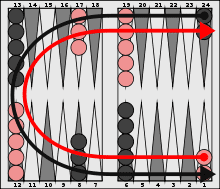 Paths of movement for red and black, with checkers in the starting position; viewed from the black side, with home or inner board at lower right
Paths of movement for red and black, with checkers in the starting position; viewed from the black side, with home or inner board at lower rightBackgammon playing pieces are known variously as checkers, draughts, stones, men, counters, pawns, discs, pips, chips, or nips.
The objective is to remove (bear off) all of one's own checkers from the board before one's opponent can do the same. The checkers are, in the most often-played variants, scattered at first, and may be blocked or hit by the opponent. As the playing time for each individual game is short, it is often played in matches, where victory is awarded to the first player to reach a certain number of points.
Each side of the board has a track of 12 long triangles, called points. The points are considered to be connected across one edge of the board, forming a continuous track in the shape of a horseshoe, and are numbered from 1 to 24. In the most commonly used setup, each player begins with fifteen checkers, two are placed on their 24-point, three on their 8-point, and five each on their 13-point and their 6-point. The two players move their checkers in opposing directions, from the 24-point towards the 1-point.
Points 1 through 6 are called the home board or inner board, and points 7 through 12 are called the outer board. The 7-point is referred to as the bar point, and the 13-point as the midpoint.
To start the game, each player rolls one die, and the player with the higher number moves first using the numbers shown on both dice. If the players roll the same number, they must roll again. Both dice must land completely flat on the right-hand side of the gameboard. The players then alternate turns, rolling two dice at the beginning of each turn.
After rolling the dice, players must, if possible, move their checkers according to the number shown on each die. For example, if the player rolls a 6 and a 3 (notated as "6-3"), the player must move one checker six points forward, and another or the same checker three points forward. The same checker may be moved twice, as long as the two moves can be made separately and legally: six and then three, or three and then six. If a player rolls two of the same number, called doubles, that player must play each die twice. For example, a roll of 5-5 allows the player to make up to four moves of five spaces each. On any roll, a player must move according to the numbers on both dice if it is at all possible to do so. If one or both numbers do not allow a legal move, the player forfeits that portion of the roll and his/her turn ends. If moves can be made according to either one die or the other, but not both, the higher number must be used. If one die is unable to be moved, but such a move is made possible by the moving of the other die, that move is compulsory.
In the course of a move, a checker may land on any point that is unoccupied or is occupied by one or more of the player's own checkers. It may also land on a point occupied by exactly one opposing checker, or "blot". In this case, the blot has been "hit", and is placed in the middle of the board on the bar that divides the two sides of the playing surface. A checker may never land on a point occupied by two or more opposing checkers; thus, no point is ever occupied by checkers from both players simultaneously. There is no limit to the number of checkers that can occupy a point at any given time.
Checkers placed on the bar must re-enter the game through the opponent's home board before any other move can be made. A roll of 1 allows the checker to enter on the 24-point (opponent's 1), a roll of 2 on the 23-point (opponent's 2), and so forth, up to a roll of 6 allowing entry on the 19-point (opponent's 6). Checkers may not enter on a point occupied by two or more opposing checkers. Checkers can enter on unoccupied points, or on points occupied by a single opposing checker; in the latter case, the single checker is hit and placed on the bar. More than one checker can be on the bar at a time. A player may not move any other checkers until all checkers on the bar belonging to that player have re-entered the board. If a player has checkers on the bar, but rolls a combination that does not allow any of those checkers to re-enter, the player does not move. If the opponent's home board is completely "closed" (i.e. all six points are each occupied by two or more checkers), there is no roll that will allow a player to enter a checker from the bar, and that player stops rolling and playing until at least one point becomes open (occupied by one or zero checkers) due to the opponent's moves.
When all of a player's checkers are in that player's home board, that player may start removing them; this is called "bearing off". A roll of 1 may be used to bear off a checker from the 1-point, a 2 from the 2-point, and so on. A die may not be used to bear off checkers from a lower-numbered point unless there are no checkers on any higher points. For example, if a player rolls a 6 and a 5, but has no checkers on the 6-point and two on the 5-point, then the 6 and the 5 must be used to bear off the two checkers from the 5-point. When bearing off, a player may also move a lower die roll before the higher even if that means the full value of the higher die is not fully utilized. For example, if a player has exactly one checker remaining on the 6-point, and rolls a 6 and a 1, the player may move the 6-point checker one place to the 5-point with the lower die roll of 1, and then bear that checker off the 5-point using the die roll of 6; this is sometimes useful tactically. As before, if there is a way to fully use the moves showing on the dice, by moving checkers within the home board and/or bearing them off, the player must do so.
If one player has not borne off any checkers by the time that player's opponent has borne off all fifteen, then the player has lost a gammon, which counts for double a normal loss. If the losing player has not borne off any checkers and still has checkers on the bar or in the opponent's home board, then the player has lost a backgammon, which counts for three times a normal loss.
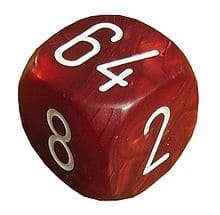 Doubling cube
Doubling cubeTo speed up match play and to provide an added dimension for strategy, a doubling cube is usually used. The doubling cube is not a die to be rolled but rather a marker with the numbers 2, 4, 8, 16, 32, and 64 inscribed on its sides, to denote the current stake. At the start of each game, the doubling cube is placed on the bar with the number 64 showing; the cube is then said to be "centered, on 1". When the cube is centered, the player about to roll may propose that the game be played for twice the current stakes. Their opponent must either accept ("take") the doubled stakes or resign ("drop") the game immediately.
Whenever a player accepts doubled stakes, the cube is placed on their side of the board with the corresponding power of two facing upward, to indicate that the right to re-double belongs exclusively to the player who last accepted a double. If the opponent drops the doubled stakes, he loses the game at the current value of the doubling cube. For instance, if the cube showed the number 2 and a player wanted to redouble the stakes to put it at 4, the opponent choosing to drop the redouble would lose two, or twice the original stake.
The game is rarely redoubled beyond four times the original stake, but there is no limit on the number of redoubles. Although 64 is the highest number depicted on the doubling cube, the stakes may rise to 128, 256, and so on. In money games, a player is often permitted to "beaver" when offered the cube, doubling the value of the game again, while retaining possession of the cube.
A variant of the doubling cube "beaver" is the "raccoon." Players who doubled their opponent, seeing the opponent beaver the cube, may in turn then double the stakes once again ("raccoon") as part of that cube phase before any dice are rolled. The opponent retains the doubling cube. E.g. White doubles Black to 2 points, Black accepts then beavers the cube to 4 points; White, confident of a win, raccoons the cube to 8 points, while Black retains the cube. Such a move adds greatly to the risk of having to face the doubling cube coming back at 8 times its original value when first doubling the opponent (offered at 2 points, counter offered at 16 points) should the luck of the dice change.
Some players may opt to invoke The Murphy rule or the "automatic double rule." If both opponents roll the same opening number, the doubling cube is incremented on each occasion yet remains in the middle of the board, available to either player. The Murphy rule may be invoked with a maximum number of automatic doubles allowed and that limit is agreed to prior to a game or match commencing. When a player decides to double the opponent, the value is then a double of whatever face value is shown (e.g. if two automatic doubles have occurred putting the cube up to 4, the first in-game double will be for 8 points). The Murphy rule is not an official rule in backgammon and is rarely, if ever, seen in use at officially sanctioned tournaments.
The Jacoby rule, named after Oswald Jacoby, allows gammons and backgammons to count for their respective double and triple values only if the cube has already been offered and accepted. This encourages a player with a large lead to double, possibly ending the game, rather than to play it to conclusion hoping for a gammon or backgammon. The Jacoby rule is widely used in money play but is not used in match play.
The Crawford rule, named after John R. Crawford, is designed to make match play more equitable for the player in the lead. If a player is one point away from winning a match, that player's opponent will always want to double as early as possible in order to catch up. Whether the game is worth one point or two, the trailing player must win to continue the match. To balance the situation, the Crawford rule requires that when a player first reaches a score one point short of winning, neither player may use the doubling cube for the following game, called the Crawford game. After the Crawford game, normal use of the doubling cube resumes. The Crawford rule is routinely used in tournament match play. It is possible for a Crawford game never to occur in a match.
If the Crawford rule is in effect, then another option is the Holland rule, named after Tim Holland, which stipulates that after the Crawford game, a player cannot double until after at least two rolls have been played by each side. It was common in tournament play in the 1980s but is now rarely used.
 Todas tablas from the Libro de los juegos
Todas tablas from the Libro de los juegosRead main article: Tables (board game)
There are many variants of standard backgammon rules. Some are played primarily throughout one geographic region, and others add new tactical elements to the game. Variants commonly alter the starting position, restrict certain moves, or assign special value to certain dice rolls, but in some geographic regions even the rules and directions of the checkers movement change, rendering the game fundamentally different.
Acey-deucey is a variant of backgammon in which players start with no checkers on the board, and must bear them on at the beginning of the game. The roll of 1-2 is given special consideration, allowing the player, after moving the 1 and the 2, to select any desired doubles move. A player also receives an extra turn after a roll of 1-2 or of doubles.
Hypergammon is a variant of backgammon in which players have only three checkers on the board, starting with one each on the 24-, 23- and 22-points. The game has been strongly solved, meaning that exact equities are available for all 32 million possible positions.
Nackgammon is a variant of backgammon invented by Nick "Nack" Ballard in which players start with one fewer checker on the six point and midpoint and two checkers on the 23 point.
Russian backgammon is a variant described in 1895 as: "...much in vogue in Russia, Germany, and other parts of the Continent...". Players start with no checkers on the board, and both players move in the same direction to bear off in a common home board. In this variant, doubles are more powerful: four moves are played as in standard backgammon, followed by four moves according to the difference of the dice value from 7, and then the player has another turn (with a few exceptions).
Gul Bara and Tapa are also variants of the game popular in southeastern Europe and Turkey. The play will iterate among Backgammon, Gul Bara, and Tapa until one of the players reaches a score of 7 or 5.
Coan ki is an ancient Chinese board game that is very similar.
Plakoto, Fevga and Portes are three versions of backgammon played in Greece. Together, the three are referred to as Tavli.
Other minor variants to the standard game are common among casual players in certain regions. For instance, only allowing a maximum of five checkers on any point (Britain) or disallowing "hit-and-run" in your home board (Middle East).
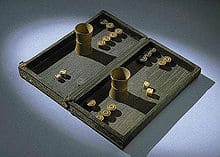 Backgammon set, 19th century
Backgammon set, 19th centuryBackgammon has an established opening theory, although it is less detailed than that of chess. The tree of positions expands rapidly because of the number of possible dice rolls and the moves available on each turn. Recent computer analysis has offered more insight on opening plays, but the midgame is reached quickly. After the opening, backgammon players frequently rely on some established general strategies, combining and switching among them to adapt to the changing conditions of a game.
The most direct strategy is simply to avoid being hit, trapped, or held in a stand-off. A "running game" describes a strategy of moving as quickly as possible around the board, and is most successful when a player is already ahead in the race. When this fails, one may opt for a "holding game", maintaining control of a point on one's opponent's side of the board, called an anchor. As the game progresses, this player may gain an advantage by hitting an opponent's blot from the anchor, or by rolling large doubles that allow the checkers to escape into a running game.
The "priming game" involves building a wall of checkers, called a prime, covering a number of consecutive points. This obstructs opposing checkers that are behind the prime. A checker trapped behind a six-point prime cannot escape until the prime is broken. A particularly successful priming effort may lead to a "blitz", which is a strategy of covering the entire home board as quickly as possible while keeping one's opponent on the bar. Because the opponent has difficulty re-entering from the bar or escaping, a player can quickly gain a running advantage and win the game, often with a gammon.
A "backgame" is a strategy that involves holding two or more anchors in an opponent's home board while being substantially behind in the race. The anchors obstruct the opponent's checkers and create opportunities to hit them as they move home. The backgame is generally used only to salvage a game wherein a player is already significantly behind. Using a backgame as an initial strategy is usually unsuccessful.
"Duplication" refers to the placement of checkers such that one's opponent needs the same dice rolls to achieve different goals. For example, players may position all of their blots in such a way that the opponent must roll a 2 in order to hit any of them, reducing the probability of being hit more than once. "Diversification" refers to a complementary tactic of placing one's own checkers in such a way that more numbers are useful.
Many positions require a measurement of a player's standing in the race, for example, in making a doubling cube decision, or in determining whether to run home and begin bearing off. The minimum total of dice rolls needed to move a player's checkers around and off the board is called the "pip count". The difference between the two players' pip counts is frequently used as a measure of the leader's racing advantage. Players often use mental calculation techniques to determine pip counts in live play.
Backgammon is played in two principal variations, "Money" and "Match" play. Money play means that every point counts evenly and every game stands alone, whether money is actually being wagered or not. "Match" play means that the players play until one side scores (or exceeds) a certain number of points. The format has a significant effect on strategy. In a match, the objective is not to win the maximum possible number of points, but rather to simply reach the score needed to win the match. For example, a player leading a 9-point match by a score of 7-5 would be very reluctant to turn the doubling cube, as their opponent could take and make a costless redouble to 4, placing the entire outcome of the match on the current game. Conversely, the trailing player would double very aggressively, particularly if he has chances to win a gammon in the current game. In money play, the theoretically correct checker play and cube action would never vary based on the score.
To reduce the possibility of cheating, most good quality backgammon sets use precision dice and a dice cup. This reduces the likelihood of loaded dice being used, which is the main way of cheating in face-to-face play. A common method of cheating online is the use of a computer program to find the optimal move on each turn; to combat this, many online sites use move-comparison software that identifies when a player's moves resemble those of a backgammon program. Online cheating has therefore become extremely difficult.
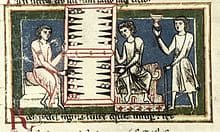 Medieval players, from the 13th century Carmina Burana
Medieval players, from the 13th century Carmina BuranaIn State of Oregon v Barr, a 1982 court case pivotal to the continued widespread organised playing of backgammon in the USA, the State argued backgammon is a game of chance and that it was therefore subject to Oregon's stringent gambling laws.
Paul Magriel was a key witness for the defence, contradicting Dr. Roger Nelson, the expert prosecution witness, by saying, "Game theory, however, really applies to games with imperfect knowledge, where something is concealed, such as poker. Backgammon is not such a game. Everything is in front of you. The person who uses that information in the most effective manner will win."
After the closing arguments, Judge Stephen S. Walker concluded that backgammon is a game of skill, not a game of chance, and found the defendant, backgammon tournament director Ted Barr, not guilty of promoting gambling.
Enthusiasts have formed clubs for social play of backgammon. Local clubs may hold informal gatherings, with members meeting at cafés and bars in the evening to play and converse. A few clubs offer additional services, maintaining their own facilities or offering computer analysis of troublesome plays. Some club leaders have noticed a recent growth of interest in backgammon, and attribute it to the game's popularity on the Internet.
A backgammon chouette permits three or more players to participate in a single game, often for money. One player competes against a team of all the other participants, and positions rotate after each game. Chouette play often permits the use of multiple doubling cubes.
Backgammon clubs may also organize tournaments. Large club tournaments sometimes draw competitors from other regions, with final matches viewed by hundreds of spectators. The top players at regional tournaments often compete in major national and international championships. Winners at major tournaments may receive prizes of tens of thousands of dollars.
The first world championship competition in backgammon was held in Las Vegas, Nevada in 1967. Tim Holland was declared the winner that year and at the tournament the following year. For unknown reasons, there was no championship in 1970, but in 1971, Tim Holland again won the title. The competition remained in Las Vegas until 1975, when it moved to Paradise Island in the Bahamas. The years 1976, 1977 & 1978 saw "dual" World Championships, one in the Bahamas attended by the Americans, and the European Open Championships in Monte Carlo with mostly European players. In 1979, Lewis Deyong, who had promoted the Bahamas World Championship for the prior three years, suggested that the two events be combined. Monte Carlo was universally acknowledged as the site of the World Backgammon Championship and has remained as such for thirty years. The Monte Carlo tournament draws hundreds of players and spectators, and is played over the course of a week.
By the 21st century, the largest international tournaments had established the basis of a tour for top professional players. Major tournaments are held yearly worldwide. PartyGaming sponsored the first World Series of Backgammon in 2006 from Cannes and later the 'Backgammon Million' tournament held in the Bahamas in January 2007 with a prize pool of one million dollars, the largest for any tournament to date. In 2008, the World Series of Backgammon ran the world's largest international events in London, the UK Masters, the biggest tournament ever held in the UK with 128 international class players; the Nordic Open, which instantly became the largest in the world with around 500 players in all flights and 153 in the Championship, and Cannes, which hosted the Riviera Cup, the traditional follow-up tournament to the World Championships. Cannes also hosted the WSOB Championship, the WSOB finale, which saw 16 players play three-point shootout matches for €160,000. The event was recorded for television in Europe airing on Eurosport.
The World Backgammon Association (WBA) has been holding the biggest backgammon Tour of the circuit since 2007, the "European Backgammon Tour" (EBGT). In 2011, the WBA collaborated with the online backgammon provider Play65 for the 2011 season of the European Backgammon Tour and with "Betfair" in 2012. The 2013 season of the European Backgammon Tour featured 11 stops and 19 qualified players competing for 19,000 € in a Grand Finale in Lefkosa, Northern Cyprus. WBA also staged the "US Open" and other events around the globe. WBA has contributed to a high-stakes event called "Crowns Cup" broadcast on several TV-channels.
When backgammon is played for money, the most common arrangement is to assign a monetary value to each point, and to play to a certain score, or until either player chooses to stop. The stakes are raised by gammons, backgammons, and use of the doubling cube. Backgammon is sometimes available in casinos. Before the commercialization of neural network programs, proposition bets on specific positions were very common among backgammon players and gamblers. As with most gambling games, successful play requires a combination of luck and skill, as a single dice roll can sometimes significantly change the outcome of the game.
Backgammon software has been developed not only to play and analyze games, but also to facilitate play between humans over the internet. Dice rolls are provided by random or pseudorandom number generators. Real-time online play began with the First Internet Backgammon Server in July 1992. It is the longest running backgammon server on the internet.
 A screen shot of GNU Backgammon, showing an evaluation and rollout of possible moves
A screen shot of GNU Backgammon, showing an evaluation and rollout of possible movesBackgammon has been studied considerably by computer scientists. Neural networks and other approaches have offered significant advances to software for gameplay and analysis.
The first strong computer opponent was BKG 9.8. It was written by Hans Berliner in the late 1970s on a DEC PDP-10 as an experiment in evaluating board game positions. Early versions of BKG played badly even against poor players, but Berliner noticed that its critical mistakes were always at transitional phases in the game. He applied principles of fuzzy logic to improve its play between phases, and by July 1979, BKG 9.8 was strong enough to play against the reigning world champion Luigi Villa. It won the match, 7-1, becoming the first computer program to defeat a world champion in any board game. Berliner stated that the victory was largely a matter of luck, as the computer received more favorable dice rolls.
In the late 1980s, backgammon programmers found more success with an approach based on artificial neural networks. TD-Gammon, developed by Gerald Tesauro of IBM, was the first of these programs to play near the expert level. Its neural network was trained using temporal difference learning applied to data generated from self-play. According to assessments by Bill Robertie and Kit Woolsey, TD-Gammon's play was at or above the level of the top human players in the world. Woolsey said of the program that "There is no question in my mind that its positional judgment is far better than mine."
Tesauro proposed using rollout analysis to compare the performance of computer algorithms against human players. In this method, a Monte-Carlo evaluation of positions is conducted (typically thousands of trials) where different random dice sequences are simulated. The rollout score of the human (or the computer) is the difference of the average game results by following the selected move versus following the best move, then averaged for the entire set of taken moves.
Neural network research has resulted in three modern proprietary programs, JellyFish, Snowie and eXtreme Gammon as well as the shareware BGBlitz and the free software GNU Backgammon. These programs not only play the game, but offer tools for analyzing games and detailed comparisons of individual moves. The strength of these programs lies in their neural networks' weights tables, which are the result of months of training. Without them, these programs play no better than a human novice. For the bearoff phase, backgammon software usually relies on a database containing precomputed equities for all possible bearoff positions.
Computer-versus-computer competitions are also held at Computer Olympiad events.
Backgammon Mobile Applications have been developed not only to play against the computer but also to play in communities over the internet.
 A game of τάβλη (tabula) played by Byzantine Emperor Zeno in 480 and recorded by Agathias in 530 circa because of a very unlucky dice throw for Zeno (red), as he threw 2, 5 and 6 and was forced to leave eight pieces alone. See "Zeno's Game of τάβλη".
A game of τάβλη (tabula) played by Byzantine Emperor Zeno in 480 and recorded by Agathias in 530 circa because of a very unlucky dice throw for Zeno (red), as he threw 2, 5 and 6 and was forced to leave eight pieces alone. See "Zeno's Game of τάβλη".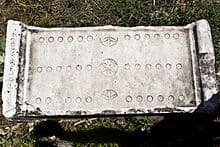 Roman Ludus duodecim scriptorum board from the 2nd century, Aphrodisias
Roman Ludus duodecim scriptorum board from the 2nd century, Aphrodisias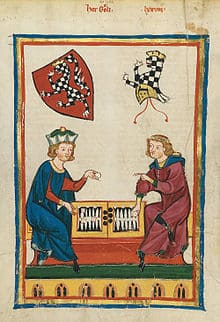 Herr Goeli, from the 14th century Codex Manesse
Herr Goeli, from the 14th century Codex ManesseTάβλη (tabula) meaning "table" or "board" in Byzantine Greek, is the oldest game with rules known to be nearly identical to backgammon; it is described in an epigram of Byzantine Emperor Zeno (AD 476-481). The board was the same with 24 points, 12 on each side. As today each player had 15 checkers and used cubical dice with sides numbered one to six. The object of the game, to be the first to bear off all of one's checkers, was also the same. Hitting a blot, reentering a piece from the bar, and bearing off, all followed the modern rules. The only differences with modern backgammon were the use of an extra die (three rather than two) and the starting of all pieces off the board (with them entering in the same way that pieces on the bar enter in modern backgammon). The name τάβλη is still used for backgammon in Greece, where it is frequently played in town plateias and cafes.
The epigram of Zeno describes a particularly bad dice roll the emperor had for his given position. Zeno, who was white, had a stack of seven checkers, three stacks of two checkers and two blots, checkers that stand alone on a point and are therefore in danger of being put outside the board by an incoming opponent checker. Zeno threw the three dice with which the game was played and obtained 2, 5 and 6. As in backgammon, Zeno could not move to a space occupied by two opponent (black) pieces. The white and black checkers were so distributed on the points that the only way to use all of the three results, as required by the game rules, was to break the three stacks of two checkers into blots, exposing them and ruining the game for Zeno.
The τάβλη of Zeno's time is believed to be a direct descendant of the earlier Roman Ludus duodecim scriptorum ("Game of twelve lines") with that board's middle row of points removed, and only the two outer rows remaining. Ludus duodecim scriptorum used a board with three rows of 12 points each with the 15 checkers being moved in opposing directions by the two players across three rows according to the roll of the three cubical dice. Little specific text about the gameplay of Ludus duodecim scriptorum has survived; it may have been related to the older Ancient Greek dice game Kubeia. The earliest known mention of the game is in Ovid's Ars Amatoria (The Art of Love) (written between 1 BC and 8 AD).
Race board games involving dice have existed for millennia in the Near East and eastern Mediterranean, including the game senet of Ancient Egypt and the Royal Game of Ur in Babylon. The ancient Egyptian game senet was excavated, along with illustrations, from Egyptian royal tombs dating to 3500 BC. Though using a board that is quite different from backgammon, it may be a predecessor. The Royal Game of Ur, originating in ancient Mesopotamia before 2600 BC, may also be an ancestor of modern-day table games like backgammon. It used tetrahedral dice. In the modern Middle East, backgammon is a common feature of coffeehouses.
Excavations at Shahr-e Sukhteh (Persian شهر سوخته, literally "The Burnt City") in Iran have shown that a board race game existed there around 3000 BC. The artifacts include two dice and 60 checkers, and the set is believed to be 100 to 200 years older than the Royal Game of Ur. On the board found at Shahr-e Sukhteh the fields are fashioned by the coils of a snake.
Touraj Daryaee (2006) - on the subject of the first written mention of early precursors of backgammon - writes:
The game of backgammon is first mentioned in Bhartrhari’s Vairagyasataka (p. 39), composed around the late sixth or early seventh century AD. The use of dice for the game is another indication of its Indic origin, since dice and gambling were a favorite pastime in ancient India. The rules of the game, however, first appeared in the Middle Persian text Wızarisnı Catrang ud Nihisnı New Ardaxsır (Explanation of Chess and Invention of Backgammon), composed in the sixth century during the rule of the Sasanian king Khosrow I (530-571). The text assigns its invention to the Persian sage Wuzurgmihr (Persian) Buzarjumihr/Bozorgmehr, who was the minister of King Khosrow I. According to the historical legend, the Indian king Dewisarm sends his minister Taxritos to Persia with the game of chess, and a letter challenging Sasanian King Khosrow I to solve the riddle or rationale for the game. Khosrow asks for three days to decipher the game, but initially no-one in the court is able to make any progress. On the third day, Khosrow's minister, Wuzurgmihr, successfully rises and explains the logic of the game. As a reciprical challenge, Wuzurgmihr constructs the game of backgammon and delivers it to the Indian king who is unable to decipher the game.
In the 11th century Shahnameh, the Persian poet Ferdowsi credits Burzoe with the invention of the tables game nard in the 6th century. He describes an encounter between Burzoe and a Raja visiting from India. The Raja introduces the game of chess, and Burzoe demonstrates nard, played with dice made from ivory and teak. Today, Nard is the name for the Persian version of backgammon, which has different initial positions and objectives. H. J. R. Murray details many versions of backgammon; modern Nard is noted there as being the same as backgammon and maybe dating back to 300-500 AD in the Babylonian Talmud, although others believe the Talmud references the Greek race game Kubeia.
Backgammon, which is known as "tavla," from Byzantine Greek τάβλη, is still a very popular game in Turkey, and it is customary to name the dice rolls with their Persian number names: yek (1), dü (2), se (3), chahar (4), pange (5), sheesh (6).
There are many variants of tavla in Turkey, where the course of play changes drastically. The usual tavla is also known as erkek tavlası meaning boys' or men's tavla. The other variant kız tavlası (meaning girls' tavla) is a game that depends only on the dice and involves no strategy. There is another variant called asker tavlası (meaning soldiers' tavla) where the pieces are thrown to the board randomly and the opponents try to flip their pieces over the opponents' pieces to beat them.
The usual Tavla rules are same as in the other neighboring Arab countries and Greece, as established over a millennium ago.
Backgammon is popular among Greeks. It is a game in which Greeks usually tease their opponent and they create a lively atmosphere. The game is called "Tavli", derived in Byzantine times from the Latin word "tabula." A game, almost identical to backgammon, called Tavli (Byzantine Greek: τάβλη) is described in an epigram of the Byzantine Emperor Zeno (AD 476-481). There are three games of Tavli commonly played:
Portes: Set-up and rules the same as backgammon, except that backgammons count as gammons (2 points) and there is no doubling cube.
Plakoto: A game where one checker can trap another checker on the same point.
Fevga: A game where one checker by itself can block a point.
These games are played one after another, in matches of three, five, or seven points. Before starting a match, each player rolls 1 die, and the player with the highest roll picks up both dice and re-rolls (i.e. it is possible to roll doubles for the opening move). Players use the same pair of dice in turns. After the first game, the winner of the previous game starts first. Each game counts as 1 point, if the opponent has borne off at least 1 stone, otherwise 2 points (gammon/backgammon). There is no doubling cube.
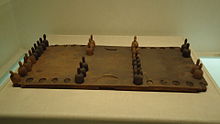 Backgammon set from around the 10th century,China
Backgammon set from around the 10th century,ChinaBackgammon was popular in China for a time and was known as "shuanglu" (双陆), with the book Pǔ Shuāng (譜雙) written during the Southern Song (1127-1279) period recording over ten variants - but over time it was replaced by other games such as xiangqi (Chinese chess).
In Japan ban-sugoroku is thought to have been introduced from China in the sixth century. As a gambling game it was made illegal several times. In the early Edo-era, a new and quick gambling game called Chō-han appeared and sugoroku quickly dwindled. By the 13th century the board game Go, originally played only by the aristocracy, had become popular among the general public.
 Brädspel ("board game") set recovered from the warship Vasa, which sank in 1628
Brädspel ("board game") set recovered from the warship Vasa, which sank in 1628The jeux de tables (Games of Tables), predecessors of modern backgammon, first appeared in France during the 11th Century and became a favorite pastime of gamblers. In 1254, Louis IX issued a decree prohibiting his court officials and subjects from playing. Tables games were played in Germany in the 12th century, and had reached Iceland by the 13th century. In Spain, the Alfonso X manuscript Libro de los juegos, completed in 1283, describes rules for a number of dice and table games in addition to its extensive discussion of chess. By the 17th Century, tables games had spread to Sweden. A wooden board and checkers were recovered from the wreck of the Vasa among the belongings of the ship's officers. Backgammon appears widely in paintings of this period, mainly those of Dutch and German painters (Van Ostade, Jan Steen, Hieronymus Bosch, Bruegel and others). Some surviving artworks are "Cardsharps" by Caravaggio (the backgammon board is in the lower left) and "The Triumph of Death" by Pieter Bruegel the Elder (the backgammon board is in the lower right). Others are the Hell of Bosch and interior of an Inn by Jan Steen.
 A Short Treatise on the Game of Back-Gammon, by Edmond Hoyle
A Short Treatise on the Game of Back-Gammon, by Edmond HoyleIn the sixteenth century, Elizabethan laws and church regulations prohibited playing tables, but by the eighteenth century backgammon was popular among the English clergy. Edmund Hoyle published A Short Treatise on the Game of Back-Gammon in 1743; this described rules and strategy for the game and was bound together with a similar text on whist.
In English, the word "backgammon" is most likely derived from "back" and Middle English "gamen", meaning "game" or "play". The earliest use documented by the Oxford English Dictionary was in 1650.
The most recent major development in backgammon was the addition of the doubling cube. It was first introduced in the 1920s in New York City among members of gaming clubs in the Lower East Side. The cube required players not only to select the best move in a given position, but also to estimate the probability of winning from that position, transforming backgammon into the expected value-driven game played in the 20th and 21st centuries.
The popularity of backgammon surged in the mid-1960s, in part due to the charisma of Prince Alexis Obolensky who became known as "The Father of Modern Backgammon". "Obe", as he was called by friends, co-founded the International Backgammon Association, which published a set of official rules. He also established the World Backgammon Club of Manhattan, devised a backgammon tournament system in 1963, then organized the first major international backgammon tournament in March, 1964, which attracted royalty, celebrities and the press. The game became a huge fad and was played on college campuses, in discothèques and at country clubs; stockbrokers and bankers began playing at conservative men's clubs. People young and old all across the country dusted off their boards and checkers. Cigarette, liquor and car companies began to sponsor tournaments and Hugh Hefner held backgammon parties at the Playboy Mansion. Backgammon clubs were formed and tournaments were held, resulting in a World Championship promoted in Las Vegas in 1967.
Most recently, the United States Backgammon Federation (USBGF) was organized in 2009 to repopularize the game in the United States. Board and committee members include many of the top players, tournament directors and writers in the worldwide backgammon community. The USBGF has recently created a Standards of Ethical Practice to address issues on which tournament rules fail to touch.